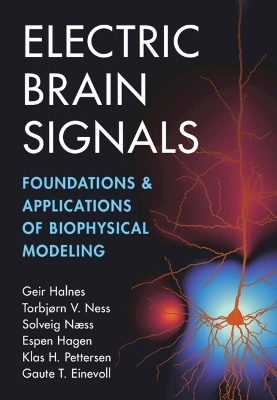
Electric Brain Signals
Cambridge University Press (Verlag)
978-1-316-51084-1 (ISBN)
It is common to study the electric activity of neurons by measuring the electric potential in the extracellular space of the brain. However, interpreting such measurements requires knowledge of the biophysics underlying the electric signals. Written by leading experts in the field, this volume presents the biophysical foundations of the signals as well as results from long-term research into biophysics-based forward-modeling of extracellular brain signals. This includes applications using the open-source simulation tool LFPy, developed and provided by the authors. Starting with the physical theory of electricity in the brain, this book explains how this theory is used to simulate neuronal activity and the resulting extracellular potentials. Example applications of the theory to model representations of real neural systems are included throughout, making this an invaluable resource for students and scientists who wish to understand the brain through analysis of electric brain signals, using biophysics-based modeling.
Geir Halnes is a Research Scientist with a background in physics and theoretical biology. For the last one-and a half decade, he has worked in the Computational Neuroscience Lab at the Norwegian University of Life Sciences. His research focuses on the fundamental physical processes in neurons, glial cells and brain tissue. Torbjørn V. Ness is a Research Scientist with a background in computational neuroscience, who has more than a decade of experience in modeling extracellular potentials, including Finite Element simulations of neural tissue and measurement equipment. Torbjørn is one of the developers of LFPy, a software for calculating brain signals from simulated neural activity. Solveig Næss is a Senior Researcher with a background in physics. She got her Ph.D. in computational neuroscience through an international Ph.D. program at the University of Oslo, Simula Research Laboratory, and the University of California, San Diego. Solveig specializes in biophysical modeling of electric brain signals. Espen Hagen is a Researcher with a background in environmental physics and computational neuroscience. He earned his Ph.D. at the Norwegian University of Life Sciences and has worked on methods and tool development, linking the activity of individual neurons and large neuronal networks to electrophysiological recordings of neural activity. Espen is one of the developers of LFPy. Klas H. Pettersen is CEO of the Norwegian Artificial Intelligence Research Consortium (NORA) spanning eleven Norwegian universities and colleges and four research institutes. He is also the founder of the AI innovation ecosystem NORA.startup. Klas is an active researcher within computational neuroscience and AI and the director of Norway's national research school on AI. Gaute T. Einevoll is Professor of Physics at the Norwegian University of Life Sciences and the University of Oslo, working on modeling of nerve cells, networks of nerve cells, brain tissue, brain signals and development of neuroinformatics software tools, including LFPy.
Preface; Abbreviations; Reserved physical symbols and quantities; 1. Introduction; 2. Charges, currents, fields and potentials in the brain; 3. Neural dynamics; 4. Volume-conductor theory; 5. Conductivity of brain tissue; 6. Schemes for computing extracellular potentials; 7. Spikes; 8. Local Field Potentials (LFPs); 9. Electroencephalography (EEG); 10. Electrocorticography (ECoG); 11. Magnetoencephalography (MEG); 12. Diffusion potentials in brain tissue; 13. Final comments and outlook; Appendix A frequency-dependent length constant; Appendix B derivation of the current-dipole approximation; Appendix C electric stimulation; Appendix D derivation of point-source equation for anisotropic medium; Appendix E statistical measures; Appendix F fourier-based analyses; Appendix G derivation of formulas for population signals; Appendix H equations for computing magnetic fields; Appendix I derivation of the MC+ED scheme; References; Index.
| Erscheinungsdatum | 25.05.2024 |
|---|---|
| Zusatzinfo | Worked examples or Exercises |
| Verlagsort | Cambridge |
| Sprache | englisch |
| Maße | 175 x 250 mm |
| Gewicht | 850 g |
| Themenwelt | Naturwissenschaften ► Biologie ► Humanbiologie |
| Naturwissenschaften ► Biologie ► Zoologie | |
| Naturwissenschaften ► Physik / Astronomie ► Angewandte Physik | |
| ISBN-10 | 1-316-51084-0 / 1316510840 |
| ISBN-13 | 978-1-316-51084-1 / 9781316510841 |
| Zustand | Neuware |
| Informationen gemäß Produktsicherheitsverordnung (GPSR) | |
| Haben Sie eine Frage zum Produkt? |
aus dem Bereich


